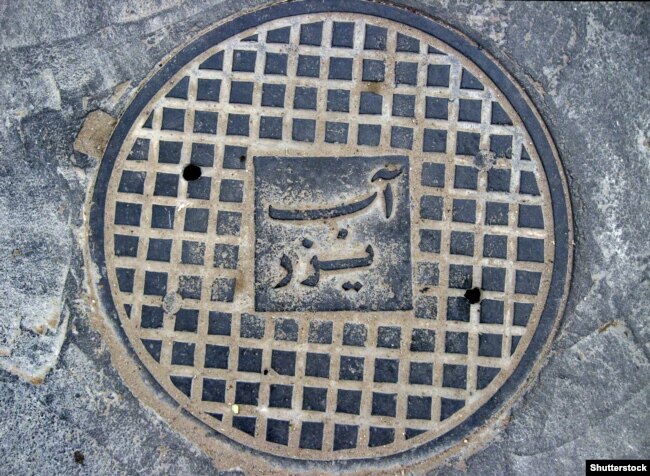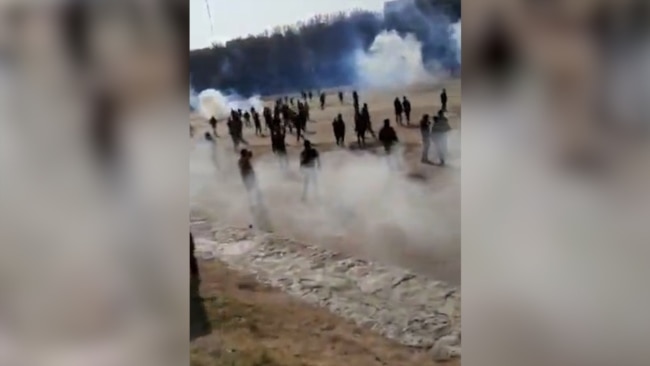RFL/RE – Iran has worked for decades to bring its sewage system into the modern age. But metal thieves are throwing a wrench in the works.
Authorities recently announced that the one of the country’s biggest public-works projects — the nearly 50-year effort to build a massive wastewater-treatment network in the capital — was “70 percent” done.
But Masud Reza Sameni, deputy head of the Tehran Sewer Company, told reporters last week that the already cash-strapped project was being threatened by the dangerous and costly theft of cast-iron manhole covers and other materials needed to finish the job.
Thousands of manhole covers installed along 7,000 kilometers of completed sewer lines have been stolen in the greater Tehran area, Sameni said on November 28.
The pilfering in Tehran has contributed to a rising trend of manhole thefts being reported across the country as an extended economic crisis, rising inflation, and the bite of international sanctions hit home.
Despite the hiring of guards, Sameni said, subcontractors reported that tools and 80 percent of the corrugated steel sheets used for the project had been stolen, forcing authorities to repurchase the items at local bazaars.
Aside from adding significantly to the price of a project that has already cost more than $300 million, Sameni said that the thefts result in safety hazards for drivers and pedestrians and can lead to corner-cutting to replace stolen items.
“Although the manhole covers are replaced immediately following citizens’ complaints,” Sameni was quoted as saying by the Tabnank news outlet, the rush means “we sometimes fall short of our technical standards. For example, concrete manhole covers are used instead of cast iron.”
A water official in central Tehran’s affluent District 3 was earlier quoted by Iranian media as saying that nearly 5,000 of the city’s estimated 150,000 manhole covers had been stolen in the past year as thieves try to cash in on rising demand and prices for scrap metal.
The official, Ali Mousavi, said that even concrete replacements had been stolen and broken up to extract steel bar.
Dangerous Trend
Tehran’s police chief has downplayed the situation, describing the stealing of materials needed for the construction of the capital’s sewer project as “petty theft” and offering assurances that there has been no increase in such crimes and that his department was taking the situation “seriously.”
But widespread reports of thefts of manhole covers and construction materials in other areas of the country point to a dangerous trend.
In the southwestern city of Ahvaz, the head of the city’s water and sewer department said on December 1 that nearly 2,000 manhole covers and hundreds of water meters had been stolen in the past nine months.

Saeed Dashtizadeh told reporters that metals theft was one of the biggest problems his department deals with.
“Because the manhole covers are made of cast iron, it is possible to sell them and thieves steal them for this reason,” the state news agency IRNA quoted Dashtizadeh as saying. “Among the dangers the theft of manhole covers poses to citizens is people, especially children, falling into the sewer.”
Dashtizadeh said that the situation had led the city to decide to install covers made of composite materials in the future.
More than 1,000 manhole covers have been reported stolen in the southern Hormozgan Province in the past six months, and arrests of manhole-cover thieves have been made in the central Isfahan Province.
In southwestern Khuzestan Province, a video of a woman trying to steal a manhole cover in broad daylight made the rounds on social media, with one commenter blaming the thefts on rising living costs and poverty.
In July, IRNA reported that a gang of four men who had used a pickup truck to steal at least 100 manhole covers in a “professional manner” were arrested.
Existential Threat
Diminishing water supplies are seen as an existential threat to Iran, where poor water management, drought, and corruption-ridden infrastructure projects have contributed to water scarcity and resulting protests around the country in recent years.
In Isfahan, civilians joined farmers last month to demand that authorities release water into the Zayandhrud River, which once flowed through the city but is now dry for most of the year.

The protests were met with violence by security forces, who arrested more than 200 people and used tear gas to disperse crowds. That crackdown followed the deaths of at least nine protesters and the detention of more than 170 others in Khuzestan Province in July.
The construction of modern wastewater treatment networks in Iran has been promoted for decades by foreign organizations including the United Nations, and has been touted as a way to cut down on water lost to evaporation or seepage, while providing treated water to irrigate crops.
In its 2012 Water Report, the UN noted that “before the Islamic Revolution wastewater treatment and reclamation was virtually nonexistent in Iran.”
As the population of Tehran grew exponentially over the past four decades, the city became one of the largest in the world without a modern system to treat wastewater, instead depending on an unorthodox and polluting method of injecting waste into the earth.
“Since the early 1990s,” the UN report said, “the general approach has been to treat the wastewater and either discharge it to the environment where it mixes with freshwater flows and is indirectly reused downstream, or by mixing it with qanat’s water use to irrigate restricted, relatively low-value crops.”
The Tehran sewerage project aims to ” improve the environmental conditions in the greater Tehran area through the installation of wastewater collection and treatment facilities to improve public health, and to further enhance irrigation systems in the surrounding areas,” according to the World Bank, which committed $150 million toward the $340 million cause in 2000.
In 2017, Iran secured a loan of just over $140 million from the Islamic Development Bank to continue the project.
Tehran Sewerage Company head Sameni said that, despite the influx of cash, more money needs to be allocated from the government’s budget, which he said has risen by only 10 percent in recent years while inflation has increased 80 percent.
If all goes well, he said, the project that began in 1975 could be completed in 10 years.
 Shabtabnews In this dark night, I have lost my way – Arise from a corner, oh you the star of guidance.
Shabtabnews In this dark night, I have lost my way – Arise from a corner, oh you the star of guidance.



